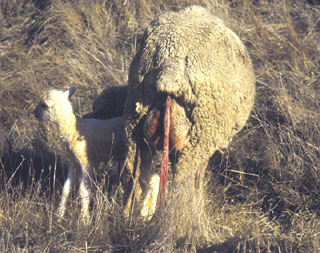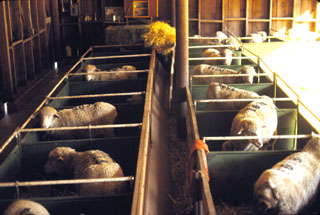A270
Getting Started in the Sheep Industry
starting a sheep flock | types
of enterprises or production systems | lambing systems
| range lambing | shed lambing
Introduction:
Sheep
are raised profitably under many production systems, operating sizes, and
combinations of resources and management techniques. While there is no one
"magic sheep production system," there is opportunity for choice.
An integrated management approach is the key to an efficient and profitable
sheep production unit. Integrated management includes knowledge in nutrition,
health, diseases, genetics, reproduction, business, and marketing. Concentration
of a producer’s efforts in only one area may be of little benefit to the big
picture. For example, management at lambing that saves a high percentage of
twins is of little use if ewes do not have the inherited potential to raise
them. On the other hand, genetic selection for twinning is a wasted effort if
the resulting offspring are not fed and managed to save a high proportion of the
extra lambs produced.
In recent years, prices sheep producers must pay for items such as feed,
equipment, labor, and interest on capital have had large increases. Add to that
the competition from imports of foreign meat and fiber. Still, only minor
increases have been seen in lamb meat, while wool prices have dropped
dramatically since the late 1980s. Despite these setbacks, technological
advances in the last several years have provided ways for many sheep operations
to become and remain profitable. This is particularly true for those producers
with entrepreneurial expertise.
Starting a Sheep Flock:
Livestock enterprises, especially dairy, poultry, and now swine, require a
very high capital investment to get started. Generally, sheep are an exception.
Sheep do not require sophisticated management practices compared to swine
production. Sheep do not require fancy or expensive facilities to thrive. They
need only to be cool and dry, with shelter for protection from adverse weather.
A three-sided or closed shed with a graded dirt floor, associated corrals and
pens, and access to feed and water are all that is required. If winter lambing
is to be practiced, a closed shelter should be considered. For additional
information on sheep handling facilities and on proper shelter during the
lambing season, refer to B300 and B488.
Small and intermediate sized sheep flocks are enjoying a degree of increasing
popularity, while large-scale extensive range sheep operations continue to
diminish. Sheep can combine some of the best profit aspects of cattle, swine,
poultry, and even goats.
Overall Conception to Consumption:
The
following diagram identifies the different markets that are available for wool
and meat. Once a market has been identified, the producer must select an
appropriate production system to meet that market. A wise producer will identify
what markets are available and then manage his/her flock to meet those markets.
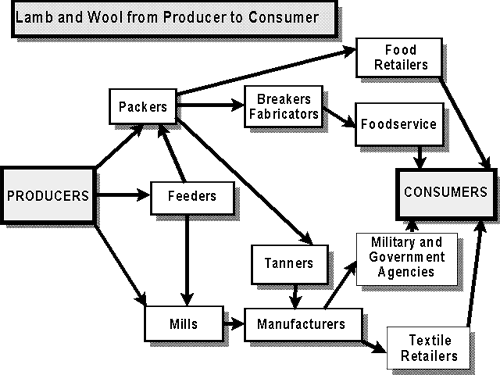
Types of Enterprises or Production Systems:
A production system is a management strategy where a specific type of animal
will be produced. As mentioned earlier, identifying a particular production
system that will meet a specific market is critical to having a profitable
operation. Examples of specific contemporary production systems are listed
below, with many of these systems outlined in a diagram format:
- Purebred
- Commercial farm flock
- Commercial range flock with market lamb production
- Commercial range flock with whiteface replacement production
- Lamb feeding
- Organic production for sheep and goats
- Purebred Sheep Production:
Purebred
animals are kept to produce foundation seedstock or breeding stock. The
offspring of these animals are usually sold as registered lambs or yearlings of
both sexes. Raising purebred animals can be challenging because of the
competition to raise superior animals. To meet this challenge, extensive efforts
should be made in feeding, care, disease prevention, and fitting for shows or
purebred sheep consignment sales. All buildings and corrals must be good looking
and well kept to attract potential buyers. Often, an aggressive advertising and
public relations program is necessary to remain profitable. Records and
performance testing are a must to help the producer identify the most productive
sheep in the flock. Enrollment in either a purebred sheep registry performance
record keeping program or NSIP (National Sheep Improvement Program) should be
considered a necessary requirement.
Sheep Commercial - Farm Flock: These
operations often use registered ram(s) on "grade" ewes. This is called
"grading-up" and should be used if the ultimate goal is a larger
number of high quality lambs per ewe bred. Like purebred flocks, decisions on
keeping or culling should be based on the genetic traits of daughters produced
and progeny testing.
Sheep Commercial - Range Operations (emphasis on market lambs):
These operations use blackface rams with whiteface ewes to produce
"terminal cross" lambs. Suffolk or Hampshire-Suffolk cross ram breeds
are commonly used for these matings. These terminal cross lambs are called
"brockle-faced" or "smut-faced" lambs. Because they are
aggressive and have rapid growth rates, they reach market maturity quickly.
These lambs are termed "terminal crosses" because they will not be
used for breeding.
Sheep Commercial - Range Operations (emphasis on replacement mothers): This
system most often uses whiteface rams (fine-wooled or dual purpose breeds) and
whiteface ewes. In many cases, virgin, yearling rams are purchased annually.
Once animals are placed in a range operation, they remain there until they
either die, become unsound, fail to pass an annual BSE (breeding soundness
evaluation), or have dental or other serious disease complications that force
their removal from the flock.
Lamb Feeding (feedlot or pasture-fed): This
is also a very common sheep production system in suitable areas in the United
States. Generally, unfinished lambs (weaners) weighing between 50 and 70
pounds are purchased, confined, and finished on hay, grain, or hay aftermath.
Corn silage with a protein supplement can also be successfully fed. This
permits a reduction in feeding costs, provided the silage facilities are being
used by some other livestock enterprise. In the western United States, feeder
or weaner lambs are generally purchased in the fall and sold throughout the
winter and early spring months.
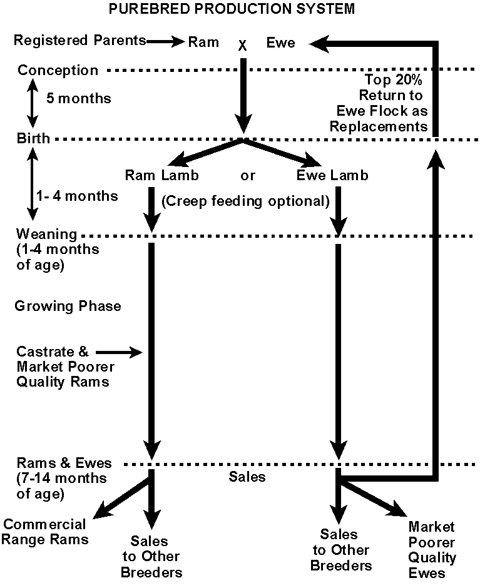
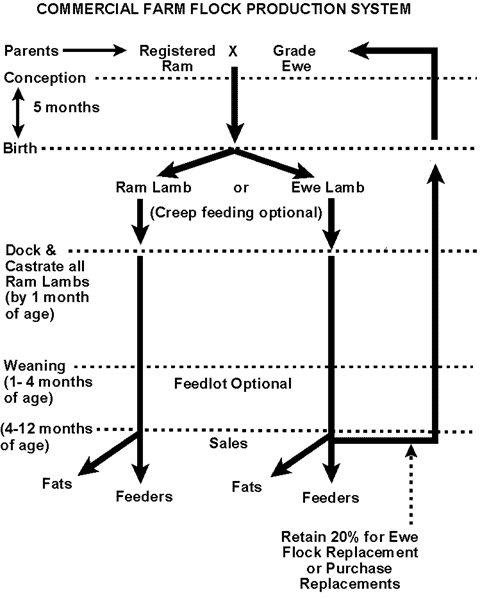
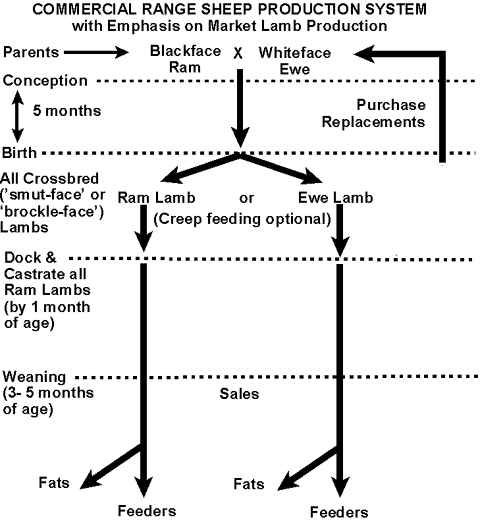
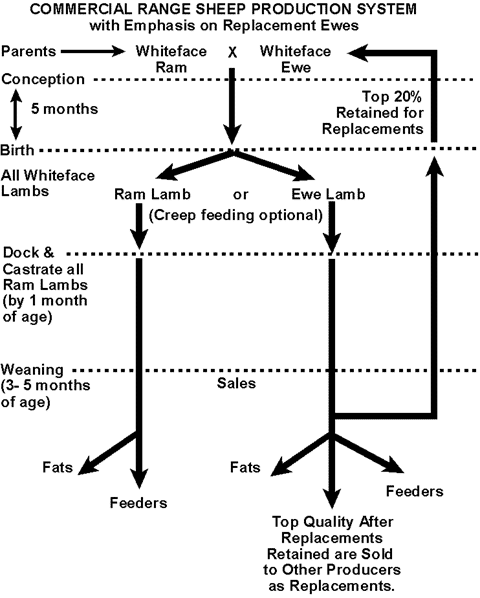
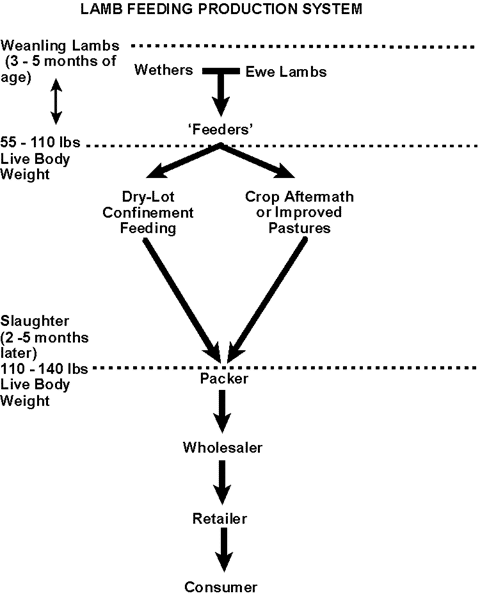
Organically Produced Sheep and Goat Fiber, Milk, or Meat
Introduction: Natural or organic agriculture is an ecological production
management system that promotes and enhances biodiversity, biological cycles,
and soil biological activity. It is based on minimal use of off-farm inputs and
on management practices that restore, maintain, and enhance ecological harmony.
"Organic" is a labeling term that denotes products produced under the
authority of the Organic Foods Production Act. "Natural" is a labeling
term that does not have any specific legislation. Organic agriculture practices
cannot ensure that products are completely free of residues; however, methods
are used to minimize pollution from air, soil, and water. Organic food handlers,
processors, and retailers adhere to standards that maintain the integrity of
organic agricultural products. The primary goal of organic agriculture is to
optimize the health and productivity of interdependent communities of soil life,
plants, animals, and people. The following are some general rules for organic
agriculture taken directly from the Organic Foods Production Act:
Livestock: Livestock grown for the production of organically or naturally
grown food or fiber may be purchased from any source.
Grazing land and pasture: Pasture land on which livestock are grazed or
pastured shall be certified as transitional or organic and shall be produced
under all requirements defined in the Organic Foods Production Act. It can
require up to three years for agricultural lands to become certified.
Fiber: Fiber
or fiber by-products sold as organically produced shall be raised from such time
such stock is brought onto a farm or field certified as transitional or organic
and fed 100% certified organically produced feeds and feed supplements for a
minimum of 12 months.
Feed: Feed fed to livestock directly or as a supplement to feed rations
shall be certified as organically produced, processed, and handled under all
requirements defined. A livestock producer shall not use feeds containing:
- Hormones, antibiotics, or other prohibited growth promoters
- Plastic pellets for roughage
- Manure
- Urea
- Materials listed as prohibited in the national listing
Feed additives fed to livestock shall meet the following requirements:
- Natural feed additives shall be from any source, provided the
additive is not categorized as prohibited on the national list.
- Synthetic feed additives may be used, provided that the additive is
categorized as allowed or restricted in the national list.
- Synthetic vitamin and mineral supplements are permitted for
documented deficiencies under the general supervision of a licensed
veterinarian as a restricted practice.
"Feed availability emergency" is a temporary shortage of certified
organically produced feed.
Health: A producer should not use growth promoters or hormones, whether
implanted, ingested, or injected, including antibiotics and trace elements
used to stimulate growth. A producer may vaccinate stock for endemic diseases
including, but not limited to, those required by state or federal law. A
producer shall not:
- Use sub-therapeutic doses of antibiotics,
- Use synthetic anthelmintics (for internal parasites) on a routine
basis, or
- Administer medication, other than vaccines, in the absence of
illness.
Disease treatment requiring applications of an external or internal
antibiotic shall be diagnosed, prescribed, and applied by or under the general
supervision of a licensed veterinarian as defined by the Food and Drug
Administration Compliance Policy Guide #7125.06, and include separation or
isolation of treated stock from the organic herd during treatment, including
the FDA recommended withdrawal period.
Fiber produced from treated stock may not be harvested for 45 days or twice
the FDA recommended withdrawal period, whichever is longer.
Parasite management may use:
- Quarantine and fecal exams for all incoming livestock
- Periodic fecal exams and culling seriously infected individuals
- Adequate pasture rotation and pasture management
- Maintaining clean facilities and proper manure management
- Vector and intermediate host control using biological controls
- Vector and intermediate host control using materials categorized as
allowed or allowed with restrictions in the national list.
Processing: Processing of organically produced or transitional meat
animals or fibers shall be in accordance with the rules established.
For More Information:
National Organic Standards Board (NOSB)
Rm. 2510, South Building
PO Box 96456
Washington, DC 20090-6456
(202) 720-5252
(202) 205-7808 FAX
Selecting Breeding Stock:
When buying breeding stock for the first time, it is often very helpful to
take a successful sheep producer along.
Where to Purchase: One place to get breeding stock is from the fall sales
that are held from August through December. Local extension agents, high school
vo-ag teachers, and other sheep producers may have information and places where
the sales are held. Breeding stock can also be purchased from purebred breeders.
What to Purchase:
Ewes: The ideal ewe is one that has had at least one lamb; however, these
animals are usually scarce. The next best animal to buy is a good ewe lamb.
Realize that more trouble is encountered at lambing time with yearlings. This is
particularly true if the producer is just starting in the sheep business and is
not an expert "lamb doctor."
Rams: When selecting a ram, it is best to buy one that has been
performance tested and has passed a BSE (Breeding Soundness Evaluation) by a
veterinarian (see B710). A performance-tested ram with a good rate of
gain and good fleece traits is more likely to produce high quality lambs than
one of unknown history.
Here are the main things to look for when buying breeding stock:
- Body: Look for ewes of good
size with a sound mouth, good udder, and good feet and legs. Reject ewes that
have a broken mouth (teeth missing). Make sure a ewe’s udder is soft and
pliable and has two well-developed teats. If older ewes are being purchased,
examine udders for missing teats that might have been snipped off during
shearing. Cull out any lame sheep. Within the high-performance-tested animals,
preference should be given to stock that have strong, broad, deep loins, and
legs well muscled down the hock. These regions of the body are where the
greatest returns are obtained from the carcass.
- Wool: Examine the fleece for uniformity and denseness. Make sure the
belly is covered with wool, with no bare patches. Make certain the wool is
free from black and kempy fibers. Notice the skin; a bright pink color
indicates a healthy animal.
- Head: Look for animals with a clean muzzle, an alert eye, and both
the upper dental pad and the lower incisors of the mouth meeting correctly.
- Legs: The legs must be sound, strong, and with good feet.
* Additional suggestions can also be found in the information on performing a
physical exam on page C634.
How Many to Purchase: It is recommended to start with no more than 50 or
60 ewes the first year. One person can easily handle 50 to 60 ewes without
additional help (except possibly at shearing time). Rams should also be
purchased. One ram for every 25 to 40 ewes is needed for successful
reproduction. During this first year, valuable skills will be developed and a
general feel for the sheep industry will be gained. These essential experiences
are necessary before any attempts should made to expand the flock.
Maintaining the Flock: Once a basic breeding flock has been established,
decisions on what animals to cull or keep can be made based on production and on
performance testing in the flock. If the rams used the first year produce the
desired type of lamb, they can be used the second year; however, a new ram
should be purchased and then used on the ewe lambs that are kept for
replacements. Select replacements from ewes that have twin lambs that grow
rapidly before and after weaning.
Lambing Systems:
Introduction:
The decision on the type
of lambing system to use is one of the most important and sometimes difficult
decisions a sheep producer must make. Factors that need to be considered include
the following:
- Climatic conditions in the area. Some breeds are more adapted for extremes
in temperature.
- Environmental conditions (type and typography of the land).
- Availability of feed supplies. Some areas have excellent grazing potential,
while others are suited for raising and harvesting forages.
- Availability of skilled labor.
- Ease and completeness of a record keeping system.
- Diseases that are common to the area.
- Types and numbers of predators that are present.
- Value of the animals being raised.
The two major types of lambing systems in the United States are referred to
as "range lambing" or "shed lambing." The advantages and
disadvantages of each system are outlined below:
Range Lambing
Advantages:
- Capital investment requirements in buildings, corrals, and equipment are
low.
- Land investments are usually made in lower priced range land and/or U.S.
Forest Service/Bureau of Land Management permits, not in high priced deeded
pasture and farmland.
- Feed inventory (on-hand) requirements are greatly reduced.
- Labor requirements are lower than in shed lambing.
- Many range lands can only be utilized by a range lambing system.
Disadvantages:
- Weaning percentages of lambs are lower (80 to 90% of ewes bred); post-docking lamb losses are high.
- Treatment of health problems and disease situations is difficult.
- Returns on investment are usually lower because of the impact of lower
lamb production.
- Lambing season is determined by climatic conditions and range forage
availability.
- Predation problems can be excessive and extreme, even if guard animals are
utilized.
Shed Lambing
Advantages:
- Weaning percentages of lambs can be greatly increased (125 to 160% of ewes
bred).
- Lamb losses can be controlled through intensive management.
- Health problems are more easily identified and treated.
- All necessary vaccinations and de-wormings can be given more easily and at
the proper time.
- Early and off season lambing is possible.
- Management practices (like docking and castration) can be performed on a
regular basis and can be part of a planned work schedule.
Disadvantages:
- Getting started usually requires a large capital investment in sheds,
buildings, corrals, and equipment.
- On hand feed inventories must be larger.
- The water source to all corrals and pens is often expensive and time
consuming to supply.
- More and better trained labor is needed.
- Concentrated animal groups, i.e. drop
bunches, jug and jail claiming
systems, can increase the chances of diseases and parasites.







